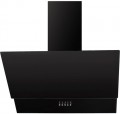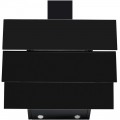Motor power
The power of the hood at maximum speed.
The more powerful the device, the more performant it is, usually. However, there is no rigid dependence here, and hoods of the same power may differ in actual performance. So it is worth evaluating power consumption in terms of power first of all: the lower this indicator, the more economical the device. And when evaluating performance, you need to look not so much at power as at the directly claimed flow of the air (see below).
Grease filter
The type of grease filter normally used in the hood. Usually, it has the appearance of a fine mesh that traps drops of fat and kitchen fumes. The grease filter can be like this:
— Metal. In this case, different materials can be used; most often, the word "metal" means a filter made of a relatively inexpensive alloy, and aluminium and stainless steel are usually listed separately (see below for more details). Common features of metal mesh are strength, durability and reusability: it is enough to wash and dry a dirty filter, after which it is ready for use again.
— Aluminium.
Filters made of aluminium alloys are considered to be very durable, because this material is highly resistant to corrosion. However, such filters are noticeably more expensive than ordinary metal ones (see above).
—
Stainless steel. Mesh made of this material has all the advantages of the metal filters described above; they are very reliable and durable, but at the same time not cheap. As a result, the use of stainless steel is typical mainly for premium hoods.
— Acrylic. A polymeric material similar to plastic. The main and the only advantage of acrylic filters is their low cost. At the same time, their service life is much shorter than that of metal ones. And some of these filters are generally disposable and cannot be cleaned after clogging. As a result, such filters are used mainly in low
...-cost models of hoods, and even then quite rarely.Controls
The control method provided in the hood.
—
Push-buttons. The most popular control method in modern hoods can be provided in devices of any functionality and price category — from low-cost models, where buttons directly control the motor, to high-end solutions with advanced electronic circuits.
—
Rotary knobs. Control with rotary knobs, sometimes supplemented by buttons or touch sensors. A rather specific option found mainly in high-end hoods, where rotary knobs are part of the design.
—
Slider. Control using the lever moved on the special panel. Usually, only power is regulated in this way: the farther the slider is from the neutral position, the more air the hood draws. A fairly universal control method, found in hoods of all price categories.
—
Touch controls. Control using touch panels is considered a sign of expensive high-end hoods. It is because it makes sense to use such panels mainly with advanced control electronics and they are poorly suited for low-cost devices. From a practical point of view, the touch controls are remarkable for their ease of use and ease of cleaning: a light touch is enough to give a command, and the panel itself has no slots or protrusions, making it easy to clean dirt.
Sleep timer
A timer that automatically turns off the hood after a predetermined time. With such a system, you do not need to wait until the completion of ventilation and turn off the device manually — just set the timer, and you can safely leave the kitchen on your own business; the hood will turn itself off at the right time.
Height (max)
The height of the entire hood structure is from the lower edge to the upper part of the body (the point of connection of the external air duct). For hoods with an adjustable design that allows you to change the height of the case, the maximum height is the size of the device in the unfolded state; in the case of non-adjustable hoods, this means a correspondingly constant overall height. When choosing a hood in height, it is worth proceeding from two points:
1. The optimal height of the air intake above the hob is 60-80 cm. This height allows the hood to capture kitchen fumes effectively and, at the same time, gives enough space to work with the hob.
2. Between the hood body and the ceiling, a clearance is required for connecting an external air duct.
Country of origin
The country in which this or that model is manufactured. Even though most of the capacities are concentrated in China, European factories for the production of household appliances have not disappeared. And certain models can be produced at them. In general, such a division into a Chinese or European factory should not particularly affect the quality of products, but the stereotype of a reliable European assembly is still present. However, it is possible that the model may have a country of manufacture, for example, Poland, and in the store under the same article, you will meet China.

